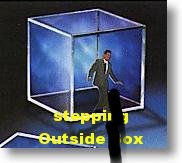|
Simplified by Walter Sorochan Posted about 2010; Updated October 2021. Warner Spring Ranch owners, a resort ranch 60 miles north-east of San Diego, California, are a mixed bag; in that there are those who think inside the box [ want to sell the ranch ] and those who think outside the box [ do not want to sell the ranch ]. Both sides think they are right in their thinking! Two persons who disagree on an issue may both be in the same box and not be aware of it. All of us, including the author, need to take a close look at ourselves, how we think and how we are acting on ranch and other matters. The author is hopeful that this condensed article will be helpful in bringing a healing and respectful understanding and solution to the ranch, climate change, potitical divide, coronavirus vaccinations and other problems. All problems can be solved! Change doesn't always come from outside the box. Andrew B. Hargadon, an Associate Professor of Technology Management at the Graduate School of Management at University of California, Davis, illustrates this: "Edison didn't invent the light bulb. In fact, his patent on the light bulb was originally turned down because it was too similar to one that was patented 30 years prior. Even Edison's laboratory assistants were in on the Great Man theory. Francis Jehl said that, once they realized that Edison the man was as important as the inventions, they all "bent towards the process of myth making" -- of making sure that everybody thought and believed that Edison was doing all of the work. It was a great way to attract investors and customers alike." Hargadon points out that many inventions come from persons who are inside many boxes and not necessarily outside the box. Back To TopThinking inside and outside the box requires innovative or creative thinking. But since innovations often destroy the box at the same time, most people can't see or won't see the disruptive innovation. To be truly innovative, you've got to find ways to change the culture or at least make people feel they can rethink not only the products and the processes, but the culture as well. Persons afraid of change, afraid of failure, afraid of criticism and who like the status quo live inside the box. Their thinking becomes inhibited! They may think they are progressive in their thinking but tend to react like someone who can see another other person's nose but not their own. A reporter wondered whether thinking outside the box really does enhance creativity. To find out, he checked in with Dr. Peter Suedfeld, a psychology professor at the University of British Columbia and an expert in human cognition. He told the reporter that creativity is a "very mysterious thing" that "exists in pretty much everyone" -- but that there are indeed ways to improve it. One method he has studied extensively is what he calls the Restricted Environmental Stimulation Technique (REST) -- putting people into places with no light or outside stimuli. "What I've found," he said, "is that far from making people crazy, moderate deprivation lowers blood pressure, improves mood, and makes people more creative." Does that mean a person wanting to be creative is better off thinking, say, inside a box? Dr. Suedfeld considered this a moment, and then said, "To the extent the box keeps the outside world away -- then, yes, it is better to think inside the box." An interesting side note: Others researchers have recently discovered that everyone can be creative, although some are more gifted than others. All children are born with lots creative ability, to think outside the box, but become less creative as they get older. Many have that " sixth sense that we are just coming to recognize. Thinking inside the box means accepting the status quo. For example, Charles H. Duell, Director of the US Patent Office, said, "Everything that can be invented has been invented." That was in 1899: clearly he was in the box! Duell: Source Back To Top
More importantly, in-the-box thinkers are skillful at killing ideas. They are masters of the creativity killer attitude such as "that'll never work" or "it's too risky." The best in-the-box thinkers are unaware that they drain the enthusiasm and passion of innovative thinkers while they kill their innovative ideas. They also believe that every problem needs only one solution; therefore, finding more than one possible solution is a waste of time. They often say, "There is no time for creative solutions. We just need THE solution." Even great creative people can become in-the-box thinkers when they stop trying. Apathy and indifference can turn an innovator into an in-the-box thinker. In only one case is in-the-box thinking necessary. This comes from a cartoon: a man talks to his cat and points to the kitty litter box. He says, "Never ever think outside the box!" Back To Top
Out-of-the box thinkers know that new ideas need nurturing and support. They also know that having an idea is good but acting on it is more important. Results are what count. A few examples of thinking outside the box:
References: Although Walter Sorochan simplified and authored this topic, the content is that of others as referenced. Back To Top |
 In-the-box thinkers find it difficult to recognize the quality of an idea. An idea is an idea. A solution is a solution. In fact, they can be quite pigheaded when it comes to valuing an idea. They rarely invest time to turn a mediocre solution into a great solution.
In-the-box thinkers find it difficult to recognize the quality of an idea. An idea is an idea. A solution is a solution. In fact, they can be quite pigheaded when it comes to valuing an idea. They rarely invest time to turn a mediocre solution into a great solution.
 Thinking outside the box requires different attributes that
Thinking outside the box requires different attributes that